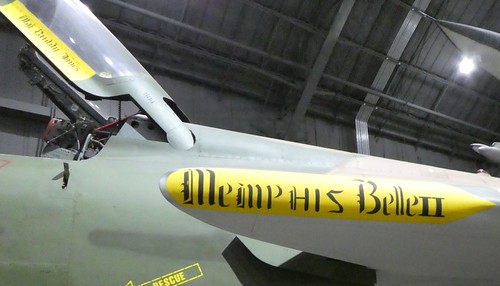The Southeast Asia War Gallery in the National Museum of the United States Air Force in Dayton, Ohio includes two F-105 Thunderchiefs.
With regard to the Southeast Asia War:
A product of the Cold War, the Southeast Asia War (1961-1973) began with communist attempts to overthrow non-communist governments in the region. United States participation in the Southeast Asia War resulted from the policy of "containment," which aimed to prevent communism from expanding beyond its early Cold War borders. The containment strategy seldom led to major combat, but as with the Korean War (1950-1953), the US committed large military forces to protect an allied, non-communist government.
The main U.S. goal in the Southeast Asia War was to protect South Vietnam -- initially from a local communist insurgency and later from conquest by communist North Vietnam. The U.S. also hoped to prevent the spread of communism to other nearby countries. Although popularly known as the Vietnam War, U.S. efforts included military action not only in South and North Vietnam, but also in neighboring Southeast Asian countries.
Republic F-105D Thunderchief
According to the Museum:
In 1951 Republic Aviation began a project to develop a supersonic tactical fighter-bomber to replace the F-84F. The result was the F-105 Thunderchief, later affectionately nicknamed the "Thud." The prototype YF-105A first flew in October 1955, but the first F-105D did not fly until June 1959. A total of 833 Thunderchiefs of all types were built, including 610 F-105Ds.
The U.S. Air Force sent F-105s to Southeast Asia shortly after the Tonkin Gulf incident in the summer of 1964. The USAF operated the F-105D extensively in the air campaign against North Vietnam called Rolling Thunder. Although designed as a nuclear strike aircraft, the F-105 could carry a total of over 12,000 pounds of conventional ordnance -- a heavier bomb load than a World War II B-17. The F-105 was gradually replaced by the F-4 Phantom, and the USAF withdrew the last F-105D from service in July 1980.
This aircraft has a top speed of 1,390 mph, a cruising speed of 778 mph, a range of 2,206 miles, and a ceiling of 51,000 feet.











Republic F-105G Thunderchief
According to the Museum:
The F-105, nicknamed the "Thud," evolved from a 1951 project by to replace the F-84F fighter-bomber. The prototype first flew in October 1955, and Republic delivered the first production aircraft to the U.S. Air Force in 1958. Republic also developed a fully combat-capable two-seat trainer version, the F-105F, and 143 of them in 1963-1964.
The Thunderchief on display began operational service in 1964 as a standard F-105F. In 1967 it joined the 355th Tactical Fighter Wing in Thailand, where it flew combat missions for nearly three years. During this time, it became one of a select few USAF aircraft to claim three MiG kills. In 1970 it was fitted with electronic counter-measure equipment and joined the 388th TFW for "Wild Weasel" duty, attacking enemy surface-to-air missile sites.
In 1972 the aircraft was modified to the improved F-105G "Wild Weasel" configuration. After another year in Thailand, it was assigned to the 35th TFW at George Air Force Base, Calif.
This aircraft has a top speed of 1,386 mph, a cruising speed of 596 mph, a range of 1,500 miles, and a ceiling of 50,000 feet.








More Air Force Museum
Air Force Museum: Sabrejets (photo diary)
Air Force Museum: MiGs (photo diary)
Air Force Museum: Southeast Asia cargo aircraft (photo diary)
Air Force Museum: Southeast Asia bombers (photo diary)
Air Force Museum: Southeast Asia air support aircraft (photo diary)
Air Force Museum: Korean War fighter planes (photo diary)
Air Force Museum: The Valkyrie (photo diary)
Air Force Museum: Southeast Asia War memorabilia (photo diary)


